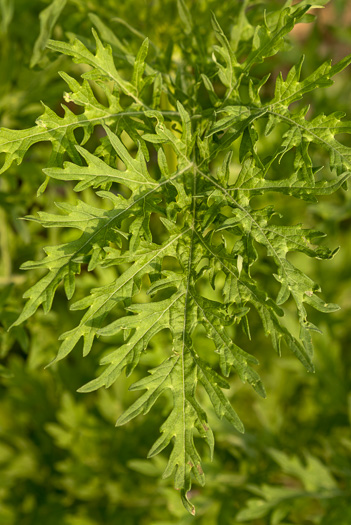Spermatophytes (seed plants): Angiosperms (flowering plants): Eudicots: Core Eudicots: Asterids: Campanulids: Asterales
WEAKLEY'S FLORA OF THE SOUTHEASTERN US (4/24/22):
Parthenium hysterophorus
FAMILY
Asteraceae
Go to FSUS key
Dig deeper at SERNEC, a consortium of southeastern herbaria.
Check out EDDMapS.org to see where this has been reported.
SYNONYMOUS WITH
PLANTS NATIONAL DATABASE:
Parthenium hysterophorus
FAMILY
Asteraceae
SYNONYMOUS WITH Floristic Synthesis of North America. BONAP (Kartesz, 2021)
Parthenium hysterophorus
SYNONYMOUS WITH Flora of North America north of Mexico, vol. 19-20-21 (2006)
Parthenium hysterophorus
SYNONYMOUS WITH Manual of the Southeastern Flora (Small, 1933, 1938)
Parthenium hysterophorus
COMMON NAME:
Santa Maria, Feverfew
To see larger pictures, click or hover over the thumbnails.
Keith Bradley kab_p_hysterophorus_07742
April Miami-Dade County FL
Leaves pinnatifid to bipinnatifid, primary sinuses 9/10+ to midrib, thin, per Weakley's Flora (2015).
WEAKLEY'S FLORA OF THE SOUTHEASTERN US (4/24/22):
Parthenium hysterophorus
FAMILY
Asteraceae
SYNONYMOUS WITH
PLANTS NATIONAL DATABASE:
Parthenium hysterophorus
FAMILY
Asteraceae
SYNONYMOUS WITH
Floristic Synthesis of North America. BONAP (Kartesz, 2021)
Parthenium hysterophorus
SYNONYMOUS WITH
Flora of North America north of Mexico, vol. 19-20-21
Parthenium hysterophorus
SYNONYMOUS WITH
Manual of the Southeastern Flora (Small, 1933, 1938)
Parthenium hysterophorus
If a search such as "Carex leptalea var. leptalea" doesn't deliver the results you want, try "Carex leptalea".
Or, to minimize chances of a misspelling, try just "Carex le".
Less is more: If "pencil flower" doesn't deliver the results you want, try "pencil".


